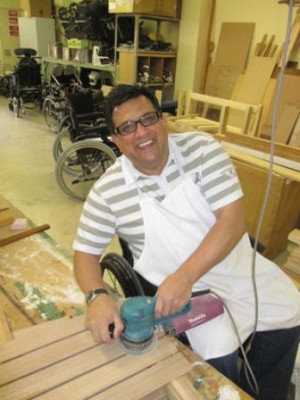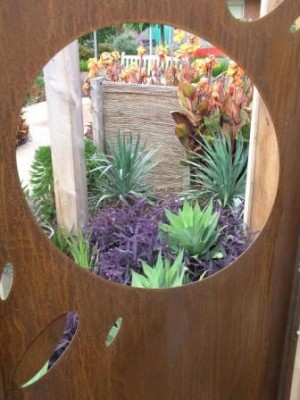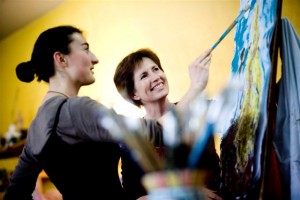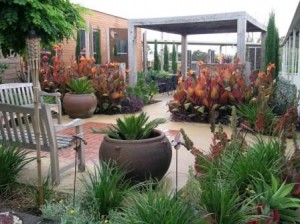I really have found this blog post particularly difficult to write – how to capture the amazing work being done while respecting the privacy of the people being helped – how to ensure I respect the professionalism of the wonderful therapists while still telling their amazing story – how to balance the emotions involved – neither maudlin nor artificially optimistic.
Rather than include this story with other stories, I felt it should – no it must – stand alone – it must have its own space!
Like all good stories, we need to start at the beginning.
Some time ago, after co-hosting the Conversation Hour with Jon Faine on ABC 774 Local Radio, I was approached by Mara Ferraro from the Creative Therapy Unit of the Royal Talbot Rehabilitaion Centre. She had heard me talking about the power of art and creative practices to help individuals and communities recover after trauma. She had contacted me to ask if I would visit and see their work. After a number of conversations, I visited the Royal Talbot Rehabilitation Centre in Kew on 9 July, spending a number of hours hearing in some detail how they use a number of creative therapies – woodwork, painting, music and horticulture in their work …….
… a bit of background…
Royal Talbot Rehabilitation Centre, as part of Austin Health’s Sub-Acute Services, is a specialist provider of intensive rehabilitation programs catering to people with a wide range of disabilities.

Art Therapy Group
Image courtesy of Royal Talbot Reehabilitation Centre
It provides a comprehensive and co-ordinated range of medical, nursing, allied health and support services to patients. Added to these services they offer a Creative Therapies Service, which consists of Art, Music, woodwork and Horticultural Therapy.
Areas of specialty include acquired brain injury rehabilitation, amputee rehabilitation, neurological rehabilitation, spinal cord injury rehabilitation, orthopaedic rehabilitation and an orthotics and prosthetics service.
On arriving at the Centre, I met Mara Ferraro, the Assistant Manager, Community Integration and Leisure Services & Creative Therapy Services, and later Sal Dema, Manager Creative Therapies. You can’t help but be moved by the passion and commitment of the therapists working here. I felt privileged to have been invited to visit, but daunted by the challenges they face in managing the unit, raising funds to keep it going and all the while, undertaking hours of clinical work each week.

The Inner Sanctuary
Image courtesy of Royal Talbot Rehabilitation Centre
My tour included talking to staff in the woodwork shop, art therapists, a walk through the beautiful garden and a brief chat with one of the music therapists, Dr Jeanette Tamplin who was awarded the University of Melbourne Chancellor’s Prize for her doctoral thesis investigating the effect of group singing on respiratory function, voice, mood and quality of life for people with chronic quadriplegia.
The horticultural therapist, Steve Wells, who has invested so much passion and one suspects, so much of himself, in creating the wonderful garden, was the ABC Gardening Australia Gardener of the Year for 2012. His garden is a place of beauty, a delight to all our senses – a place to touch, to smell, to see, to listen to the gentle flow of water in a fountain and to meditate in a place of tranquility.

Duke working on his woodwork project
Image courtesy of Royal Talbot Rehabilitation Centre
The woodwork shop is another place where patients can create with wood – including making everyday items specially designed to assist those with physical disabilities.
It is wonderful to see the joy in the eyes of patients working in the woodshop – the same joy I experience when working in my workshop – the smell of the timber, the touch to ensure you have sanded your work to the necesssary smoothness, the satisfaction of completing your piece and the sense of achievement.
Most importantly, the wonderful feeling that comes when you are doing something creative.
Like so many absolutely vital organisations across our society, the wonderful work undertaken by the Creative Therapies Unit could not be delivered without volunteers – fundraising, helping in the various therapy units, being involved in activities of all descriptions – I suspect Royal Talbot would struggle without their huge contribution.

View into the Garden Rooms
Image courtesy of Royal Talbot Rehabilitaion Centre
The walls in the centre are covered with artworks – paintings and drawings in a wide variety of styles.
Despite this diversity, they all share one thing in common.
They are deeeply emotional – they capture the struggle of dealing with a situation that would challenge almost all of us. They also project the strength and dignity and individuality of the artist and creator.
They say so much without a word being spoken.
I have really only had a snap shot of the work of this marvellous institution.
To visit on a bright sunny winter day, to stand in the gardens just a stone’s throw from the Yarra River and the national parkland, to listen to the melodious song of the many magpies and other birds, it would be easy to forget where you are.
However, you are very quickly brought back to reality when you hear the story of the patient willing herself to make the demanding effort to push her wheelchair up the incline to the meditation room in the garden, setting a difficult physical target in order to spend time meditating in this peaceful space. Seeing the patients and hearing of their efforts to get the best out of the situation they are in – to find ways to live their lives to the fullest extent possible – brings their struggle and needs into sharp focus.
You wonder how you would cope if it was you.
Mosaic – Talbot Community Project – 2013
Image courtesy of Royal Talbot Rehabilitation Centre
… so, what now?
The Royal Talbot Rehabilitation Centre Creative Therapy Unit needs our help.
The work of this unit in providing the significant therapeutic benefits of creative practices to assit with rehabilitation for those in our community who are unfortunate enough to suffer from aquired brain injury, or a severe stroke or quadraplegia, or who are amputees is insuffficiently recognised. The great work done to assist these people in their move back into the community needs more support. They rely heavily on community support.
It is supported and assisted by many wonderful, commited volunteers. There are many people doing what they can to raise money to assist in this work. The Creative Therapy Unit has an outstanding patron in the person of the highly respected Australian musician Lindsay Field.
The Centre has just held its major annual fund raiser – the mosaic above, completed as a Talbot community project, was auctioned on the night.
But they need more – more money – more volunteers – more exposure – more opportunity to tell their story – to show Victorians just how much creative therapy can help with rehabilitation, can assist as patients move back into the community, can provide pleasure and even joy when the situation is so very, very hard.
Creative therapy can make life better for people who need, and deserve all the help we can provide.
As I said at the outset, I was initially somewhat daunted at the sheer scale and difficulty of the task confronting the management, staff and volunteers at the Creative Therapy Unit, but Sal and Mara quickly corrected me – as Sal puts it:
‘Don’t be daunted Bruce. We have been chipping away for years now and we have had our wins and losses but we are still here! I am buoyed by the fact that we still have the range of programs and services (no matter how small at present) embedded within this setting and the impact it has for the patients and the culture of the place. If it’s meant to be, it will happen.
The last couple of years we have realised the need to shift our focus so that there are more people telling our story. So keep sharing our story and as you said ‘where and when it is appropriate’ hopefully we will be able to carve out another chip’.
So, what can you do to help?
If you think you can help in any way, contact:
b


